by Meike van Ginneken, Water Envoy of the Kingdom of The Netherlands
At the COP climate summit in Dubai, I discussed how climate change manifests itself through water. A few days later, I saw this firsthand in my home country, The Netherlands.
Around the world, people experience climate change through water. Homes flood. Harvests fail because the rains come late. Businesses shut down because of drought.
In December 2023, The Netherlands faced flood risks through a combination of saturated soils, soaring river discharges, high tides and strong winds. While each of these events by itself is not exceptional, the combination of events is.
So water management faced a stress test. Water management in The Netherlands combines engineering solutions and in recent years more nature-based approaches.
Spoiler alert – The Netherlands passed the stress test. With the exception of some minor disruption, no major flooding occured.
All major storm surge barriers along the coast of the Netherlands were closed. Engineers were excited as the mighty Maeslant storm surge barrier closed automatically for the first time since its completion in 1997.
A few days later, floodplains along the major rivers filled up with water. The water took the ‘room for the river’ that had been created in the past twenty years by moving dikes further inland. Authorities decided to temporarily flood emergency overflow areas – low lying nature or agricultural land – to prevent greater social damage downstream.
Water authorities communicated proactively using excellent weather and water data and thorough emergency communication planning.
The high water got a lot of press coverage in the slow news weeks around the holidays. On Christmas prime minister Rutte thanked water workers for their vigilance. A visit to the photogenic vast swaths of water in rivers became a favorite family trip. Specialists and opinion makers debated on television about investments in flood protection, building restrictions in flood prone areas and nature preservation. These were the down-to-earth versions of the complex discussions I had participated in at the COP in Dubai.
With climate change, extreme weather and water events will occur more often. If water is the problem, good water management is the solution.
Governments, businesses and people around the world face difficult choices. They will have to agree on risk appetite. And they will face questions on climate justice including who will have to pay.
Engineering and technology will remain important. But engineering solutions alone will not be sufficient to adapt to the changing climate. Protection and restoring freshwater ecosystems will help to create water buffers against floods and droughts. And water will need to become central to spatial and economic planning.
Extreme events test our water management. They also generate important public debate. Throughout history, disasters or near-disasters have triggered policy changes and increased investments. As Dutch water managers say: Give us our daily bread, and once in a while an acute water threat.




